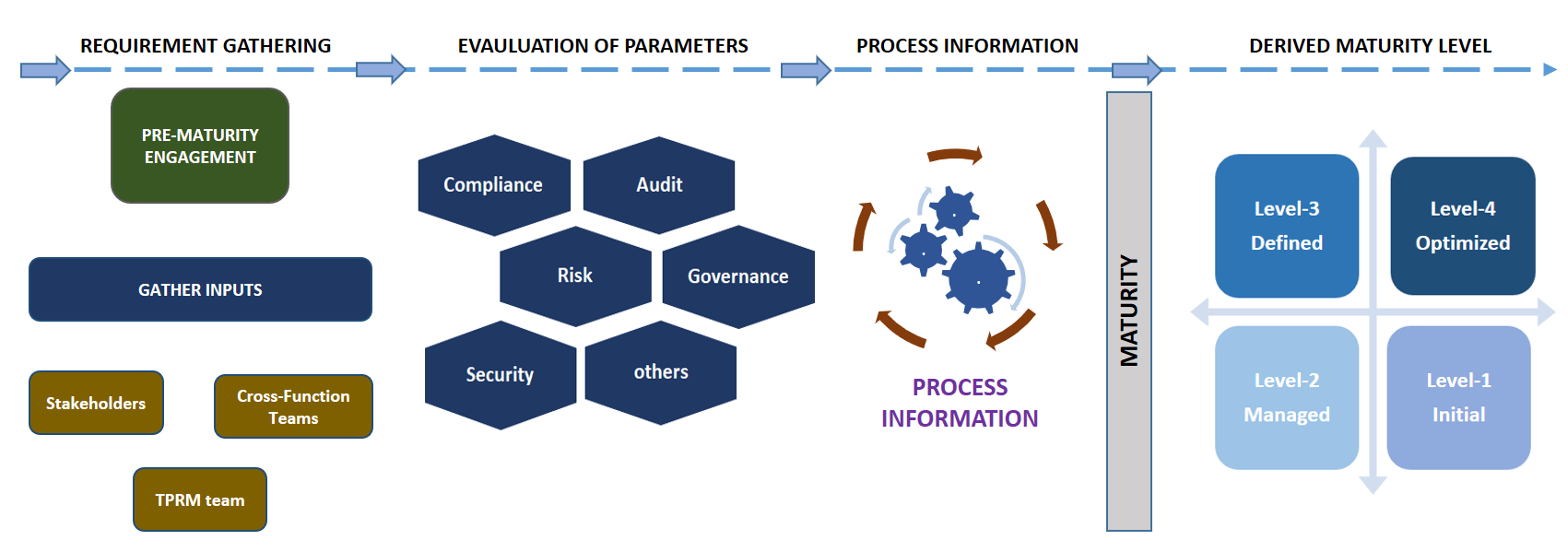Stay improved. Stay Matured.

Maturity Assessment is a method to capture the perceived (current state) maturity level, which can be applied to a specific business line, program or to the organization as a whole. Maturity assessments indicate how an organization is performing at a given time by giving unique inputs and learning about the pain points, strengths, and gaps throughout the process. Maturity assessments can be a big contributor to the strategy of the organization in terms of resources, cost and time.
TPRM Maturity Assessments is a method to assess the current state of the program by evaluating the essential and key components of the TPRM program, analyzing the result of the evaluation to derive intelligent insights and to deduce the plan for a higher maturity level.
Defentrix classifies TPRM maturity level into four categories from Low (Initial) to High (Optimized).
Maturity Assessment is carried out against certain defined Key parameters that control and influence the TPRM program and associated activities. Information gathered for each of the parameters is put through the algorithm and the maturity level is determined. Parameters include but are not limited to Governance, Compliance, Identity and Access, Risk, Audit, Incident, Asset, Teams etc.
Higher maturity levels enable the organization to demonstrate
Well-defined and comprehensive processes that leave no room for confusion and ambiguity
Stakeholders aligned to TPRM program objectives
Reduced TAT, adherence to SLA and improved reporting
Tool-based assessments with partial or full automation
Capability to perform re-assessments
High return on investment
Optimal working conditions and adequate resources for the TPRM team
Challenges of Low Maturity Level Faced by the Businesses
- Strategic risk arising due to low maturity level where a higher maturity level needs to be maintained
- Inadequate investment in the maturity of the TPRM program
- Lack of well-defined processes, standard operating procedures and cross-team coordination
- Sub-optimal performance that is not aligned with Stakeholder expectation
- Frequent breaches of SLA and higher TAT
- Complex reporting leading to unsatisfactory statistics
Defentrix uses its industry experience and expertise to derive your current maturity level and provides guidance on how to move to a higher maturity level
Work with us to improve your Maturity Level
Methodology
Evaluate the current maturity level
- Understand the existing framework, processes, workflow and dataflow
- Engage with stakeholders to understand the current state and desired future state
Assess TPRM program parameters and their respective maturity level
Derive key outcomes via report
Prioritize the action plan for management (MAP)

Benefits of achieving a Higher Maturity Level
Focus on the key pain areas to ease the program activities
Achieve greater control over the process and procedures
Understand the involvement of missing Stakeholders
Focus on parameters that enable the program
Justify the need for additional resources and budget
Gain optics on the non-compliance against the requirements of security standards and regulations

Worried about your Information Security and TPRM?
Contact us today for complete consulting and implementation of Information Security
Latest Resources
2024 Leadership Vision for Third Party Risk Management (TPRM)
CISOs have a diverse array of rapidly evolving priorities, threats, demands, regulatory pressures, and technology changes to address. Leaders need a structured approach to today's security and risk landscape covering third-party risk. This blog sheds light on...
TPRM Awareness, upskill and cross skill
The security world is very diversified, with the majority of the organizations practicing defensive security while a few have adopted offensive security as well. Security professionals need to keep abreast with developments in Third Party Risk Management space and...
DPDP Act 2023 (India) and Third Party Risk Management (TPRM)
The impact of globalization, social networking, outsourcing, adoption of cloud and technologies, cross border data flows are some of the prominent reasons why data collection and sharing is ubiquitous in this digital age. Many countries have realized the importance of...



